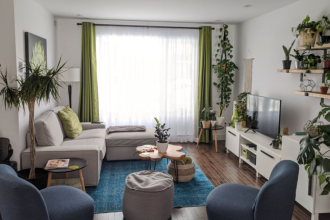Plants and flowers are likely to be the first things that come to mind when considering how to make your plain garden more appealing and inviting.
- Step 1: Introduction to the tile top patio table
- Step 2: Create the bending jig, full-size leg template, and tabletop core
- Step 3: Form the steel legs and attach the cement board to the top
- Step 4: Finish by wrapping your design and waterproofing the disc
- Step 5: Cover the table’s edge with tile
- Step 6: Cover the top with tile
- Step 7: Attach the table legs and grout the tabletop
While adding some greenery and beautiful flowers to your outdoor space is essential, it is also worth considering how outdoor furniture can transform your garden into a nice place to spend time. This article will teach you how to build an outdoor table with a steel base and a tile top. Take the time to read the steps below, as the details below will also be of great assistance to you in making a custom and creative bases for your table.
Step 1: Introduction to the tile top patio table
This table is simple to build and requires only basic skills and tools. Purchase your steel and wood from a home improvement store, and check for an exceptional tile supplier in your area. Inquire about weather-resistant stone or porcelain tiles (or a combination of the two). Our table, which was made from two different sizes of stone tile, cost roughly one-fifth the price of a store-bought table.
This tabletop is made out of wood covered with cement board, insulated with a paint-on membrane, and protected with grout and ceramic tile. Its leg base is made from durable steel bars from a local hardware store or a home center that you flex into a nice curve with the help of a template and a homemade jig. Before screwing them to the tabletop, drill and assemble them.
Step 2: Create the bending jig, full-size leg template, and tabletop core
Create a bending jig out of a 16 x 36-in. 3/4-in. If you’re going to use a plywood sheet and two rounded-over lengths of 2×4, glue the 2x4s to the plywood and drive eight 2-in. The screws go through the bottom side of the plywood into each 2×4. You may be wondering why there are so many screws. Well, as you bend the steel bars, these chunks of 2×4 will be put under a lot of stress.
Then, from a 4 x 4 feet of 1/2-inch thick CDX plywood sheet, make two plywood discs. Because you’ll be covering all sides of it, expensive plywood isn’t entirely necessary. If the plywood is slightly bowed, placing the bows opposite each other will cancel the warp when screwed together.
Step 3: Form the steel legs and attach the cement board to the top
Using a permanent marker, mark every inch of the 1/4-in. x 1-1/2 in. x 36-in. steel bar. Connect the marks to the center marks on the 2×4 blocks and securely pull the bar until it flexes slightly. Move the bar to the next inch mark and gently bend it at each one.
Drag the bar between the blocks, aligning the foremost mark with the center and pulling the bar in your direction. Since you have several mechanical advantages, this first little bend is simple. Don’t overbend; a small nudge at each mark will result in a pretty good and even curve.
Step 4: Finish by wrapping your design and waterproofing the disc
Roughen the edges of the discs with a rasp, then sand them by hand with coarse sandpaper. Wipe away the debris and apply a coat of waterproofing membrane with a roller or brush available at home improvement stores and tile suppliers.
The membrane will prevent moisture from entering the disc and causing the core to swell and eventually crack. Apply at least two coats, allowing each to dry in between. Lay out your tile design and test it while the outer layer is drying (about 24 hours). To assist with the placement of the tile, consider making a cardboard disc the very same size as your coated disc and outline concentric circular guidelines on it.
Step 5: Cover the table’s edge with tile
Apply thin-set mortar to the back of each tile, then place it on the edge of the table disc, adjusting the height as needed. Cut or adjust the tile spacing to accommodate the final piece as you work your way around the disc. Prior to actually tiling the top, wait at least 24 hours.
You might need to shim the entire top slightly above the workbench or shim each tile with pieces of thin cardboard. Vary according to the size of the tile, the tile can be significantly lower than the bottom edge or even slightly higher than the bottom edge; neither variation from flush will be visible on a fully completed table.
Step 6: Cover the top with tile
With a permanent marker, draw guidelines on your tabletop, and then trowel mortar onto only one quadrant of the top with a 1/4-in. trowel. As you move your tile from your design to the mortared top, pay close attention to your guidelines. Before grouting the top, finish each quadrant, then allow the mortar to set for at least 24 hours.
Step 7: Attach the table legs and grout the tabletop
Attach the legs to the top, and ensure to adjust the leg pattern to match the top. Our leg assembly was aligned with the tile cross on the tabletop.
Seal your tile before grouting if it is absorbent. However, because our tile was stone without a glaze, we bought a sealer, rolled it on, and let it dry before grouting. The sealer prevents the grout from hazing the surface of the stone. If you use glazed tile, there is no need to seal it. The grout should be mixed in the same way as the mortar.
Last but not least, you’ll need to paint the legs and wood leg braces to keep them from rusting. To do this, remove the legs. To prepare the surface, paint the wood braces and then wipe the steel with mineral spirits and scuff it with steel wool. Prepare the steel before painting it.













